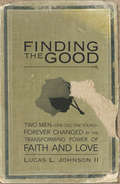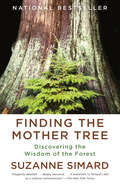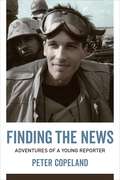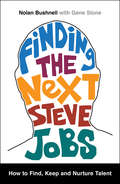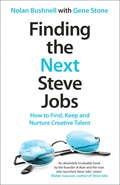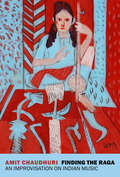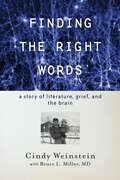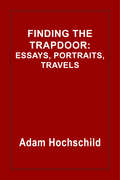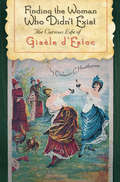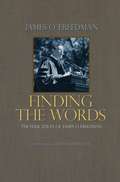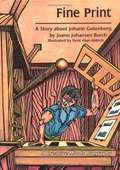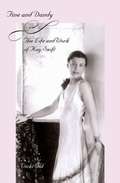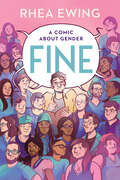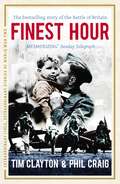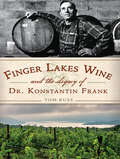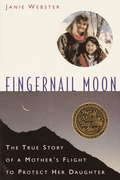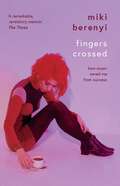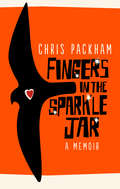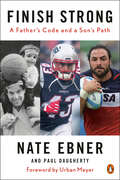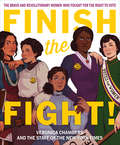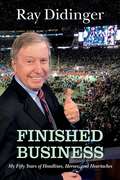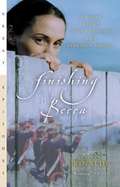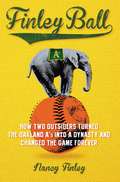- Table View
- List View
Finding the Good
by Lucas JohnsonLike Tuesdays with Morrie, in which Mitch Albom gleans wisdom from his mentor, Finding the Good is the story of Fred Montgomery and his influence on Lucas Johnson, a young reporter who learns of the transforming power of faith and love. Here is a powerful story of a 20th century slave who rose to the rank of mayor and the young man whose life he touched. Fred Montgomery, the son of sharecroppers in west Tennessee, and boyhood friend of Alex Haley, grew up in poverty, but had a faith and confidence instilled in him by his parents. Always at the mercy of white people, Fred worked hard and acquired his own farm in spite of opposition from his white neighbors. After losing two of his sons in separate drowning accidents, Fred tried twice to commit suicide. Bitter from years of frustration brought upon him by whites, Fred's attitude was changed by the sympathy and love shown to him by his neighbors, white and black alike. In 1988 he proved that faith and love can prevail by becoming the first black mayor of the once strongly segregated Henning, Tennessee. While telling this story, the author shows glimpses of his own life, in which many of his relatives, including his own father, succumbed to the lure of alcohol and drugs. Lucas Johnson lost all hope. He had no faith; he had no love. "Years have passed," he concludes," since I first met Fred Montgomery. . . . I'm a better person because of him. His life . . . gave me a credible blueprint on how to deal with life's problems and even grow stronger from them."
Finding the Mother Tree: Discovering the Wisdom of the Forest
by Suzanne SimardFrom the world's leading forest ecologist who forever changed how people view trees and their connections to one another and to other living things in the forest--a moving, deeply personal journey of discovery <P><P>Suzanne Simard is a pioneer on the frontier of plant communication and intelligence; she's been compared to Rachel Carson, hailed as a scientist who conveys complex, technical ideas in a way that is dazzling and profound. Her work has influenced filmmakers (the Tree of Souls of James Cameron's Avatar) and her TED talks have been viewed by more than 10 million people worldwide. <P><P>Now, in her first book, Simard brings us into her world, the intimate world of the trees, in which she brilliantly illuminates the fascinating and vital truths--that trees are not simply the source of timber or pulp, but are a complicated, interdependent circle of life; that forests are social, cooperative creatures connected through underground networks by which trees communicate their vitality and vulnerabilities with communal lives not that different from our own. <P><P>Simard writes--in inspiring, illuminating, and accessible ways--how trees, living side by side for hundreds of years, have evolved, how they perceive one another, learn and adapt their behaviors, recognize neighbors, and remember the past; how they have agency about the future; elicit warnings and mount defenses, compete and cooperate with one another with sophistication, characteristics ascribed to human intelligence, traits that are the essence of civil societies--and at the center of it all, the Mother Trees: the mysterious, powerful forces that connect and sustain the others that surround them. <P><P>Simard writes of her own life, born and raised into a logging world in the rainforests of British Columbia, of her days as a child spent cataloging the trees from the forest and how she came to love and respect them--embarking on a journey of discovery, and struggle. <P><P>And as she writes of her scientific quest, she writes of her own journey--of love and loss, of observation and change, of risk and reward, making us understand how deeply human scientific inquiry exists beyond data and technology, that it is about understanding who we are and our place in the world, and, in writing of her own life, we come to see the true connectedness of the Mother Tree that nurtures the forest in the profound ways that families and human societies do, and how these inseparable bonds enable all our survival. <P><P><b>A New York Times Bestseller</b>
Finding the News: Adventures of a Young Reporter
by Peter CopelandFinding the News tells Peter Copeland’s fast-paced story of becoming a distinguished journalist. Starting in Chicago as a night police reporter, Copeland went on to work as a war correspondent in Latin America, the Middle East, and Africa before covering national politics in Washington, DC, where he rose to be bureau chief of the E. W. Scripps Company. The lessons he learned about accuracy and fairness during his long career are especially relevant today, given widespread concerns about the performance of the media, potential bias, and the proliferation of so-called “fake news.” He offers an honest and revealing narrative, told with surprising humor, about how he learned the craft of news reporting.Copeland’s story begins in 1980, when a colleague hastily declared him a full-fledged reporter after barely four days of training. He went on to learn the business the old-fashioned way: by chasing the news in thirty countries and across five continents. As a young person entering journalism and reporting during some of recent history’s most fraught military situations— including Operation Desert Storm and the US invasions of Panama and Somalia—Copeland discovered the craft was his calling. Looking back on his career, Copeland asserts his most important lessons were not about reporting, writing, or the latest technologies, but about the core values that underlie quality journalism: accuracy, fairness, and speed. Replete with behind-the-scenes stories about learning the trade, Copeland’s inspiring account builds into a heartfelt defense of journalism “done the right way” and serves as a call to action for today’s reporters. The values he learned as a cub reporter are needed now more than ever, he argues, as the integrity and motives of even seasoned journalists are called into question by political partisans. Copeland admits that those critics are not entirely wrong but contends that exciting new technologies, combined with a return to old-school news values, could usher in a golden age of journalism.
Finding the Next Steve Jobs
by Gene Stone Nolan BushnellIn Silicon Valley legend Nolan Bushnells first book, he explains how to find and hire employees who have the potential to be the next Steve Jobs. Nolan Bushnell founded the groundbreaking gaming company Atari in 1972, and two years later employed Steve Jobs, as well as many other creatives over the course of his five decades in business. Here Bushnell explains how to find, hire, and nurture the people who could turn your company into the next Atari or the next Apple. Bushnells advice is constantly counter-intuitive, surprising, and atypical. When looking for employees, ignore credentials. Hire the obnoxious (in limited numbers). Demand a list of favorite books. Ask unanswerable questions. Comb through tweets. Just because youve hired creatives doesnt mean youll keep them. Once you have them, isolate them. Celebrate their failures. Encourage ADHD. Ply them with toys. Encourage them to make decisions by throwing dice. Invent haphazard holidays. Let them sleep. The business world is changing faster than ever, and every day your company faces new complications and difficulties. The only way to resolve these issues is to have a staff of wildly creative people who live as much in the future as the present, who thrive on being different, and whose ideas will guarantee that your company will prosper when other companies fail. Bio: About the Authors Nolan Bushnell is the founder of video game company Atari, Chuck E. Cheese-the first restaurant to integrate gaming into its entertainment model-as well as twenty-five other companies. Bushnell has been inducted into the Video Game Hall of Fame and the Consumer Electronics Association Hall of Fame, received the BAFTA Fellowship, and was named one of Newsweeks "50 Men Who Changed America. " Hes a frequent subject of media coverage and was prominently featured in Walter Isaacsons best selling book, Steve Jobs. Gene Stone, a former book, magazine, and newspaper editor for such companies as the Los Angeles Times, Esquire, Harcourt Brace, and Simon & Schuster, has ghostwritten thirty books (many of which were New York Times bestsellers) for a wide range of people in many different fields. Stone has also written numerous titles under his own name, including The Secrets of People Who Never Get Sick, which has been translated into more than twenty languages; the New York Times bestseller Forks Over Knives; and The Watch, the definitive book on the wristwatch. Editorial Reviews: "The man who helped give a generation the game of Pong now gives a new generation a series of pongs for their careers. Nolan Bushnells book is a spirited and insightful road map for anyone trying to navigate the new world of work. " -- Daniel H. Pink, author of To Sell Is Human and Drive "Nolan is a genius, and a generous one, too. Like most geniuses who share their secrets, his secrets are simple, and available to anyone with the guts to listen. " -- Seth Godin, Author, The Icarus Deception
Finding the Next Steve Jobs: How to Find, Keep and Nurture Creative Talent
by Gene Stone Nolan BushnellHow to Find, Keep and Nurture Creative TalentNolan Bushnell founded the groundbreaking gaming company Atari and two dozen other companies. He also launched Steve Jobs' career, along with those of many other brilliant creatives over the course of his five decades in business. In his eagerly awaited first book, Bushnell explains how to find, hire, and nurture the people who could turn your company into the next Atari or the next Apple. The business world is changing faster than ever, and every day your company faces new complications and difficulties. The only way to resolve these issues is to have a staff of wildly creative people who live as much in the future as in the present, who thrive on being different, and whose ideas will guarantee that your company will prosper when other companies fail.
Finding the Raga: An Improvisation on Indian Music
by Amit ChaudhuriAn autobiographical exploration of the role and meaning of music in our world by one of India's greatest living authors, himself a vocalist and performer.Amit Chaudhuri, novelist, critic, and essayist, is also a musician, trained in the Indian classical vocal tradition but equally fluent as a guitarist and singer in the American folk music style, who has recorded his experimental compositions extensively and performed around the world. A turning point in his life took place when, as a lonely teenager living in a high-rise in Bombay, far from his family&’s native Calcutta, he began, contrary to all his prior inclinations, to study Indian classical music. Finding the Raga chronicles that transformation and how it has continued to affect and transform not only how Chaudhuri listens to and makes music but how he listens to and thinks about the world at large. Offering a highly personal introduction to Indian music, the book is also a meditation on the differences between Indian and Western music and art-making as well as the ways they converge in a modernism that Chaudhuri reframes not as a twentieth-century Western art movement but as a fundamental mode of aesthetic response, at once immemorial and extraterritorial. Finding the Raga combines memoir, practical and cultural criticism, and philosophical reflection with the same individuality and flair that Chaudhuri demonstrates throughout a uniquely wide-ranging, challenging, and enthralling body of work.
Finding the Right Words: A Story of Literature, Grief, and the Brain
by Cindy WeinsteinThe moving story of an English professor studying neurology in order to understand and come to terms with her father's death from Alzheimer's.In 1985, when Cindy Weinstein was a graduate student at UC Berkeley, her beloved father, Jerry, was diagnosed with early-onset Alzheimer's disease. He was fifty-eight years old. Twelve years later, at age seventy, he died having lost all of his memories—along with his ability to read, write, and speak. Finding the Right Words follows Weinstein's decades-long journey to come to terms with her father's dementia as both a daughter and an English professor. Although her lifelong love of language and literature gave her a way to talk about her grief, she realized that she also needed to learn more about the science of dementia to make sense of her father's death. To write her story, she collaborated with Dr. Bruce L. Miller, neurologist and director of the Memory and Aging Center at the University of California, San Francisco, combining personal memoir, literature, and the science and history of brain health into a unique, educational, and meditative work. Finding the Right Words is an invaluable guide for families dealing with a life-changing diagnosis. In chapters of profound and sometimes humorous remembrance, Weinstein relies on literature to describe the shock of her father's diagnosis and his loss of language and identity. Writing in response to Weinstein's deeply personal narrative, Dr. Miller describes the neurological processes responsible for the symptoms displayed by her father. He also reflects upon his own personal and professional experiences. In a final chapter about memory, Weinstein is able to remember her father before the diagnosis, and Miller explains how the brain creates memories while sharing some of his own. Their two perspectives give readers a fuller understanding of Alzheimer's than any one voice could.
Finding the Speed of Light: The 1676 Discovery That Dazzled The World
by Mark WestonKirkus Star Mark Weston’s high-interest story and Rebecca Evans’s colorful graphics make scientific discovery the coolest thing this side of Jupiter. More than two centuries before Einstein, using a crude telescope and a mechanical timepiece, Danish astronomer Ole Romer measured the speed of light with astounding accuracy. How was he able to do this when most scientists didn’t even believe that light traveled? Like many paradigm-shattering discoveries, Romer’s was accidental. Night after night he was timing the disappearance and reappearance of Jupiter’s moon Io behind the huge, distant planet. Eventually he realized that the discrepancies in his measurements could have only one explanation: Light had a speed, and it took longer to reach Earth when Earth was farther from Jupiter. All he needed then to calculate light’s speed was some fancy geometry.
Finding the Trapdoor
by Adam HochschildThe vivid, suspenseful history books for which Adam Hochschild has become well known are only a portion of his work. All his life he has also been writing shorter pieces: about the writers he loves, about his unusual life story, and about his travels to far corners of the earth-four continents, for example, are included in this volume. Finding the Trapdoor collects the best of more than two decades' worth of such articles, all of them previously published in a wide variety of magazines, from Mother Jones to the Village Voice to the New York Review of Books. The topics covered range from a visit to Amazon Indians several days' travel from the nearest small town to a look at late 20th-century sex advice books to the story of how two of Hochschild's personal heroes once fought on opposite sides of a battle in the Russian Civil War.Adam Hochschild's books include King Leopold's Ghost: A Story of Greed, Terror and Heroism in Colonial Africa; Bury the Chains: Prophets and Rebels in the Fight to Free an Empire's Slaves; and Half the Way Home: A Memoir of Father and Son. He teaches at the Graduate School of Journalism, University of California at Berkeley, and has written for the New Yorker, the New York Review of Books, Harper's, The Atlantic, and many other magazines."Clearly fascinated by the world beyond himself, Hochschild extracts the essences of Russia, El Salvador, South Africa, Senegal, Colombia and Mississippi 30 years after Freedom Summer. An enthralling excursion around the world and into the heart."- Publisher's Weekly"Wherever he takes you-to a combat zone in El Salvador, an anti-apartheid rally in South Africa, the claustrophobic apartments of Moscow-you will find the place lit up with gentle humor and a luminous moral intelligence.- Barbara Ehrenreich"A rich and rewarding adventure in the reading."- Studs Terkel
Finding the Woman Who Didn't Exist: The Curious Life of Gisèle d'Estoc
by Melanie C. HawthorneGisèle d&’Estoc was the pseudonym of a nineteenth-century French woman writer and, it turns out, artist who, among other things, was accused of being a bomb-planting anarchist, the cross-dressing lover of writer Guy de Maupassant, and the fighter of at least one duel with another woman, inspiring Bayard&’s famous painting on the subject. The true identity of this enigmatic woman remained unknown and was even considered fictional until recently, when Melanie C. Hawthorne resurrected d&’Estoc&’s discarded story from the annals of forgotten history.Finding the Woman Who Didn&’t Exist begins with the claim by expert literary historians of France on the eve of World War II that the woman then known only as Gisèle d&’Estoc was merely a hoax. More than fifty years later, Hawthorne not only proves that she did exist but also uncovers details about her fascinating life and career, along the way adding to our understanding of nineteenth-century France, literary culture, and gender identity. Hawthorne explores the intriguing life of the real d&’Estoc, explaining why others came to doubt the &“experts&” and following the threads of evidence that the latter overlooked. In focusing on how narratives are shaped for particular audiences at particular times, Hawthorne also tells &“the story of the story,&” which reveals how the habits of thought fostered by the humanities continue to matter beyond the halls of academe.
Finding the Words: The Education of James O. Freedman
by James O. FreedmanJames Freedman, the fifteenth president of Dartmouth College, began life in a struggling middle-class Jewish family in a provincial industrial New Hampshire town. By the time of his death from cancer in March 2006, he was one of the most celebrated educational leaders of his generation, perhaps of the twentieth century. Finding the Words is Freedman's account of the first twenty-seven years of this astonishing trajectory in a life made difficult by depression, but sustained throughout by a love of books and learning, a life that would transform the culture of American higher education. His mother's fierce and bruising ambition instilled in him an overwhelming drive to leave his mark upon the world. His father, a revered high-school English teacher who was timid outside the classroom, introduced him to the rich world of literature--and also passed on to him his doubts and insecurities. Freedman retraces his intellectual formation as a student, educator, scholar, and leader, from his early?obsession with book collecting through his undergraduate years at Harvard and his professional training at Yale Law School. This same passion for language and ideas defined Freedman's leadership at Dartmouth, where he deftly countered lingering anti-Semitism, fought entrenched interests to open the way for women and minorities, reformed and revitalized the curriculum, and boldly reconceived the school's campus. This moving and inspiring book vividly depicts the formative years of a man nourished by lifelong learning, whose rise from humble beginnings to heights of achievement will serve as a model for generations to come.
Fine Print: A Story about Johann Gutenberg
by Joann Johansen BurchRecounts the story of the German printer credited with the invention of printing with movable type.
Fine and Dandy: The Life and Work of Kay Swift
by Vicki OhlKay Swift (1897-1993) was one of the few women composers active on Broadway in the first half of the twentieth century. Best known as George Gershwin's assistant, musical adviser, and intimate friend, Swift was in fact an accomplished musician herself, a pianist and composer whose Fine and Dandy (1930) was the first complete Broadway musical written by a woman. This book - the first biography of Swift - discusses her music and her extraordinary life. Vicki Ohl describes Swift's work for musical theater, the ballet, Radio City Music Hall's Rockettes, and commercial shows. She also tells how Swift served as director of light music for the 1939 World's Fair, eloped with a cowboy from the rodeo at the fair, and abandoned her native New York for Oregon, later fashioning her experiences into an autobiographical novel, Who Could Ask for Anything More? Informed by material, including Swift's unpublished memoirs and extensive interviews with her family members and friends, this book captures the essence and spirit of a remarkable woman. --BOOK JACKET. Title Summary field provided by Blackwell North America, Inc. All Rights Reserved
Fine: A Comic About Gender
by Rhea EwingWashington Post • 10 Best Graphic Novels of 2022 A vibrant and informative debut with “great documentary power” (Alison Bechdel), Fine is an elegantly illustrated celebration of the transgender community. As graphic artist Rhea Ewing neared college graduation in 2012, they became consumed by the question: What is gender? This obsession sparked a quest in which they eagerly approached both friends and strangers in their quiet Midwest town for interviews to turn into comics. A decade later, this project exploded into a sweeping portrait of the intricacies of gender expression with interviewees from all over the country. Questions such as “How do you Identify” produced fiercely honest stories of dealing with adolescence, taking hormones, changing pronouns—and how these experiences can differ, often drastically, depending on culture, race, and religion. Amidst beautifully rendered scenes emerges Ewing’s own story of growing up in rural Kentucky, grappling with their identity as a teenager, and ultimately finding themself through art—and by creating something this very fine. Tender and wise, inclusive and inviting, Fine is an indispensable account for anyone eager to define gender in their own terms.
Finest Hour: The bestselling story of the Battle of Britain (Extraordinary Lives, Extraordinary Stories of World War Two #3)
by Phil Craig Tim ClaytonSeventy years ago, Europe lay at Hitler's feet. Britain faced its darkest hour - outnumbered and friendless as the German army continued its advance. Defeat or capitulation seemed inevitable. But instead a legend was born. Taking its readers on a breathtaking journey from open lifeboats in Atlantic gales to the cockpits of burning fighter-planes, and through cities devastated by the Blitz, FINEST HOUR recreates the terror, the tragedy and the triumph of the Battle of Britain. This powerful account of the events of 1940 is told through the voices, diaries, letters and memoirs of the men and women who lived, loved, fought and died during this terrible yet inspiring year. FINEST HOUR blends original historical research with the experiences of ordinary people in desperate times. Cutting through the nostalgic haze, this book enables readers to experience a time - still within living memory - when a nations's darkest hour became its finest.
Finger Lake Wine and the Legacy of Dr. Konstantin Frank (American Palate)
by Tom RussThe remarkable story of a refugee from Soviet Ukraine who found his way to upstate New York—and changed the American wine industry. Dr. Konstantin Frank forever changed the palate of American wine. Forced from his home in Soviet Ukraine during World War II, he was astounded by the terroir when he arrived in the Finger Lakes region, an agricultural scientist from a foreign land desperately looking for work. Against popular notions, he believed that the vinifera grapes that produced some of Europe&’s and California&’s finest wines would prosper in this part of New York State, but was met with skepticism and resistance. He proved his detractors wrong, and because he shared his knowledge freely with others, Konstantin&’s innovativeness has allowed the region to produce some of the world&’s finest Riesling, Chardonnay, Pinot Noir, and other varietals. Four generations of Franks have continued his legacy, and their winery has won record numbers of prestigious awards every year. This book tells the inspiring story. Includes photographs
Fingernail Moon: The True Story of a Mother's Flight to Protect Her Daughter
by Janie WebsterIn January 1990, Janie Webster packed a few possessions and left San Francisco in the dark of night with her six-year-old daughter. She was certain of only one thing: She had to protect her child, even if it meant giving up everything and living life on the run. Janie Webster had an enviable marriage, a beautiful child, and enjoyable work. But when she discovered that her husband had sexually abused their daughter, everything changed. She began divorce proceedings, but the court allowed unsupervised visits between father and daughter. Then her husband was diagnosed with AIDS. Terrified that he could further abuse and even infect their daughter, Janie Webster knew that she had to flee. Mother and daughter embarked on a five-year journey, traveling to Japan, Australia, New Zealand, Singapore, Greece, Italy, Switzerland, Scotland, England, and Ireland. Although often discouraged, they found within their physical journey a deep spiritual meaning. With God's guidance, they established and reestablished new lives in the countries where they stayed, finding people they could trust, who provided them with friendship and assistance. With no way to prove the validity of their story, they learned not only to trust but also to be trusted. Despite the threat of deportation and imprisonment hanging over them, as well as their weariness from the strains of traveling, they sensed the hand of God engineering their safe passage. This chronicle of their fugitive years is a compelling journal of courage in the face of uncertainty, and the power of faith. It challenges us to ask ourselves how far we would go to keep our children safe and encourages us to listen to them and find the strength to act on their behalf.
Fingers Crossed: How Music Saved Me From Success
by Miki BerenyiThe Shoegaze Story of a Britpop Star#1 New Release in Composer & Musician BiographiesGo behind the curtain of London’s Britpop industry as music icon Miki Berenyi revisits the people and memories that changed her life foreverA rising star in the darkness. Growing up with a dubious family life, Miki never thought that music would be her ticket out of a cycle of neglect, exploitation, and struggling with her mental health. But soon after meeting fellow rock fan Emma Anderson, she found herself going from attending gigs to becoming a member of Lush, the most popular Britpop band in the world. Now she shares all in Fingers Crossed, an incredible confession about how the power of music can bring people together to share an ethereal experience. Featuring honest truths and hopeful reflections, this celebrity memoir will inspire you to find your own triumphs by embracing what you love.Fame, friendship, and life under the spotlight. Lush had become Miki’s sanctuary, but life wasn’t all glitz and glamour. With cutthroat competition, a complicated relationship with Emma, and Lush’s tragic end, she shares how she juggled her private life with her new rock band identity. Miki’s life story will captivate you and prompt you to consider this: you, too, can achieve happiness during difficult times. After all, tribulations create the strongest voices.Inside Fingers Crossed, you’ll also find:What the early indie years of Lush were likeWhy money doesn’t mean prosperityHow Britpop industry pitted female singers and musicians against each otherFinding how artists (and everyone else) can find new meanings after saying goodbyeIf you love music biographies such as The Woman in Me, My Effin’ Life, or Karma, you’ll love Fingers Crossed.
Fingers Pointing Toward the Sacred: a Twentieth Century Pilgrimage on the Eastern and Western Way
by Frederick FranckTake part in a fascinating spiritual travelogue around the world with renowned artist, sculptor, and author Frederick Franck as he visits Sri Lanka, India, the Himalayas, and Japan. Along the way he relates events of the journey to memories of his life, tying past and present together with a series of flashbacks that add depth and richness to the narrative. Sit in on intimate, probing conversations with the twentieth century giants of faith he has met: Pope John XXIII, the Dalai Lama, Albert Schweitzer, D.T. Suzuki, and many others. In his quest for a spirituality which can be found at the heart of all religions, he moves beyond theological rhetoric to explore the deep spiritual resonances between Buddha-Nature and Christ-Consciousness. This book is the culmination of wisdom from a lifelong internal and external pilgrimage by the author of the classic book, The Zen of Seeing. Including charming drawings which Franck sketched along the way, this is a "road story" in the tradition of the ancient legends of heroes on the path of self-discovery. For all twentieth century pilgrims, Franck's fingers truly do point toward the Sacred.
Fingers in the Sparkle Jar: A Memoir
by Chris PackhamVoted the UK’s Favourite Nature BookThe memoir that inspired Chris Packham's BBC documentary, Asperger’s and MeEvery minute was magical, every single thing it did was fascinating and everything it didn't do was equally wondrous, and to be sat there, with a Kestrel, a real live Kestrel, my own real live Kestrel on my wrist! I felt like I'd climbed through a hole in heaven's fence.An introverted, unusual young boy, isolated by his obsessions and a loner at school, Chris Packham only felt at ease in the fields and woods around his suburban home. But when he stole a young Kestrel from its nest, he was about to embark on a friendship that would teach him what it meant to love, and that would change him forever. In his rich, lyrical and emotionally exposing memoir, Chris brings to life his childhood in the 70s, from his bedroom bursting with fox skulls, birds' eggs and sweaty jam jars, to his feral adventures. But pervading his story is the search for freedom, meaning and acceptance in a world that didn’t understand him.Beautifully wrought, this coming-of-age memoir will be unlike any you've ever read.
Finish Strong: A Father's Code and a Son's Path
by Paul Daugherty Nate EbnerThe inspiring story of Nate Ebner's bond with his unconventional father and its remarkable consequencesNate Ebner and his father were inseparable. From an early age, they worked side-by-side in the family junkyard, where part of the job was dispensing citizen's justice to aspiring robbers, and they worked out side-by-side in their grungy homemade gym. Even though Nate was a great peewee football player in football-mad Ohio, he followed his father's passion for rugby and started playing for the same club as his father when he was only thirteen years old. But Nate had to face the fact that there was no way to make a living as a professional rugby player in this country. So Nate gave his dad the news that he planned to quit rugby and go out for the football team at Ohio State University, with an eye toward making the NFL. As a goal for someone who hadn't even played high school football, this was completely ridiculous. Without blinking, his father told him that if he gave up what he had built in rugby, he had to see it through. It was the last conversation they ever had--the next day, his father was brutally murdered at work by a would-be robber. Nate went on to make the Ohio State team and when NFL Draft Day came, he was selected by the New England Patriots. Three Super Bowl rings later, his legacy in the sport is secure. But he got another unexpected chance to honor his father's memory when the Olympics admitted rugby as a sport for the 2016 Games. Against long odds, he made the team and competed in Rio in the sport he and his father loved above all others.An astonishing story of what a father will do for a son and what a son will do for a father, Finish Strong is a powerful reminder that the lessons parents embody for their children continue to bear fruit long after they are gone.
Finish the Fight!: The Brave and Revolutionary Women Who Fought for the Right to Vote
by Veronica Chambers The Staff of The New York TimesWho was at the forefront of women's right to vote? We know a few famous names, like Susan B. Anthony and Elizabeth Cady Stanton, but what about so many others from diverse backgrounds—black, Asian, Latinx, Native American, and more—who helped lead the fight for suffrage? On the hundredth anniversary of the historic win for women's rights, it's time to celebrate the names and stories of the women whose stories have yet to be told. Gorgeous portraits accompany biographies of such fierce but forgotten women as Yankton Dakota Sioux writer and advocate Zitkála-Šá, Mary Eliza Church Terrell, who cofounded the National Association of Colored Women (NACW), and Mabel Ping-Hua Lee, who, at just sixteen years old, helped lead the biggest parade in history to promote the cause of suffrage. FINISH THE FIGHT will fit alongside important collections that tell the full story of America's fiercest women. Perfect for fans of GOOD NIGHT STORIES FOR REBEL GIRLS and BAD GIRLS THROUGHOUT HISTORY.
Finished Business: My Fifty Years Of Headlines, Heroes, And Heartaches
by Ray DidingerDidinger began following the Eagles as a kid, hanging out in his grandfather’s bar in Southwest Philadelphia. He spent his summers at the team's training camp in Hershey. It was there he met his idol, flanker Tommy McDonald. He would later write a play, Tommy and Me, about their friendship and his efforts to see McDonald enshrined in the Pro Football Hall of Fame. Didinger has been covering the Eagles as a newspaper columnist or TV analyst since 1970. Over the years, he wrote sports for the Philadelphia Bulletin and the Philadelphia Daily News. He later produced Emmy Award–winning documentaries for NFL Films before transitioning to sports talk radio and TV analysis. <P><P> In five decades, across multiple media platforms, he has interviewed everyone from Hank Aaron, Wayne Gretzky, Muhammad Ali, Julius Erving, Jack Nicklaus, to Mike Schmidt, as well as writing film scripts for Hollywood stars such as Bruce Willis and Alec Baldwin. He went to the White House with the U.S. Olympic team and even explored the bizarre world of professional wrestling. His stories, told in his familiar, breezy style, capture his enthusiasm for sports and his affection for the fans who still mourn the pennant that eluded the Phillies in 1964. Didinger has become synonymous with Philadelphia sports, and his memoir is as passionate as an autumn Sunday at Lincoln Financial Field.
Finishing Becca: A Story about Peggy Shippen and Benedict Arnold
by Ann RinaldiA fourteen-year-old maid witnesses the events that lead to General Benedict Arnold's betrayal of the American forces during the Revolutionary War.
Finley Ball: How Two Baseball Outsiders Turned the Oakland A's into a Dynasty and Changed the Game Forever
by Nancy FinleyThis is the story of a losing baseball team that became a 1970s dynasty, thanks to the unorthodox strategies and stunts of two very colorful men. <P><P>When Charlie Finley bought the A's in 1960, he was an outsider to the game-a insurance businessman with a larger-than-life personality. He brought his cousin Carl on as his right-hand man, moved the team from Kansas City to Oakland, and pioneered a new way to put together a winning team. With legendary players like Reggie Jackson, Catfish Hunter, and Vida Blue, the Finleys' Oakland A's won three straight World Series and riveted the nation. <P><P>Now Carl Finley's daughter Nancy reveals the whole story behind her family's winning legacy-how her father and uncle developed their scouting strategy, why they employed odd gimmicks like orange baseballs and "mustache bonuses," and how the success of the '70s Oakland A's changed the game of baseball.
